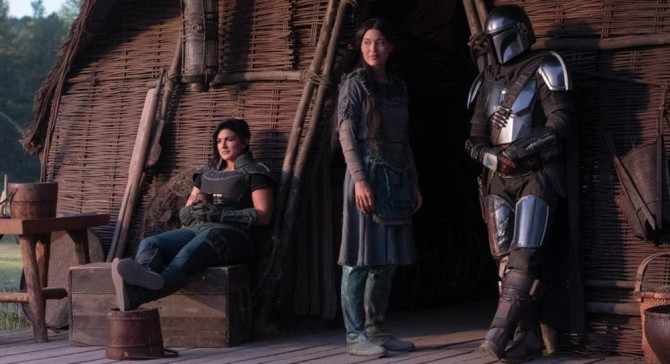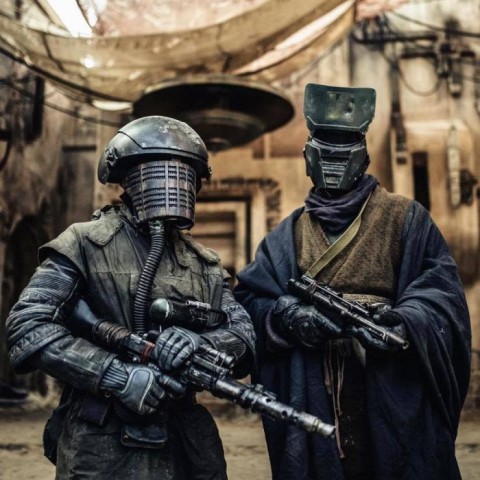There have been a lot of people championing the arrival of live-action Star Wars in the TV format, including myself (The Mandalorian arrives next Tuesday!). A large contingent of Star Wars fans are frustrated with where the films have gone and their hope is that TV will infuse Star Wars with fresh energy. In particular, it will allow them to flesh out characters and build some real depth into the universe.
However, there’s a potential pitfall awaiting The Mandalorian that I’ve been worried about ever since a TV show was announced. It has a connection to the Scriptshadow triumvirate, our famous three-ingredient rule for screenwriting success – GSU. GSU stands for goal, stakes, and urgency and it’s the last letter in the acronym we should be concerned about. Because what a lot of people don’t realize is that Star Wars is heavily dependent on URGENCY.
Take a look at the first Star Wars – A New Hope. That film is pure urgency. It starts with a giant ship chasing a tiny ship. Two droids escape from that ship and the chase is on for the bad guys to capture them. Even as Luke and Obi-Wan are chilling in his bungalow, Darth Vader is fast closing in, determined to find the droids. And once our heroes end up at the Death Star, the urgency is ramped up ten-fold.
Empire Strikes Back takes a similar approach with Darth Vader on a relentless pursuit to find Luke Skywalker. And Return of the Jedi keeps the urgency at the forefront with the Rebels determined to take down the new Death Star before it becomes operational.
There are many problems with the prequels but the one that gets overlooked is the lack of urgency. I would argue it’s the primary reason why those films didn’t live up to the Star Wars name. There was some attempt at urgency in Phantom Menace with the threat of war on Naboo looming. But it went out the window when the characters got stuck on Tatooine, and later, Coruscant, seemingly with all the time in the world.
Attack of the Clones was the biggest offender, sending two of its characters, Anakin and Padme, to a planet where they could run around in fields and tell each other they loved each other for what seemed like years. I barely remember Episode 3, but from what I do remember, we have a time jump in the film. There should never ever be a time jump in a Star Wars film. It is the definition of non-urgent if you can take four months off in the middle of a story.
Then came Force Awakens. What was the defining storytelling component in that film? It was urgency. The script moved incredibly fast. I would argue too fast. But it’s not a surprise that that film was liked by so many. It brought back the key ingredient to successful Star Wars movies. Rogue One had some sense of urgency but not a lot. That may be why it’s seen as an average Star Wars film. And while Last Jedi had a ticking time bomb with the First Order chasing a Resistance ship, it was offset by the fact that it was a (purposefully) slow chase.
To summarize, the four most successful Star Wars movies (Star Wars, Empire, Jedi, and Force Awakens) all put a major emphasis on URGENCY, which is proof to me that urgency is an ingredient necessary to make Star Wars work. Which brings us to The Mandalorian TV show. TV shows are NOT about urgency. They can’t be. They don’t have the budget to continuously keep everyone moving. This is why so many scenes in TV shows are characters talking in rooms. The budget necessitates it.
Characters in a room is fine when the characters are great, when there’s an adequate amount of conflict, when the writers are utilizing subtext (there’s the scene we’re seeing and the scene that’s happening underneath the scene), when characters are faced with hard choices that go against their makeup, when characters are working through a problem with major consequences attached.
HOWEVER…
Is that Star Wars?
One of the major things that separates features from TV shows is urgency. Go watch any of your favorite movies. Because movies must conclude, there’s usually a force pushing the characters towards that conclusion. That force creates a sense of urgency. But TV shows don’t need to conclude. So any force is far off in the distance. There are ways to combat this, of course. You can create more immediate goals that keep your characters active in the present episode (“Go visit Krybor on the planet of Fizzlestrom. But hurry, he’s on his death bed.”). But, again, inevitably, TV has to put people in rooms talking without any urgency. And we’ve never seen Star Wars under these conditions.
There’s a bigger discussion to be had here that you’re probably picking up on. Features favor urgency. TV favors character development. But I believe that urgency helps EVERY story, regardless of format. If they had the money, more TV shows would try and inject urgency into their storylines. And there’s some that have. I didn’t watch 24 but I think every episode of that show had extreme urgency, right? That was part of its hook?
One of the reasons hospital shows do so well is there’s a built-in urgency to the formula. There’s always somebody coming through the ER who’s just been hit by a bus and will lose their face if Dr. Johnson doesn’t figure out a way to save it before the hour’s over. But even those shows can’t keep it up all the time. Go back and watch episodes of ER and you see tons of doctors sitting around talking about things.
You also have to understand how to implant urgency into a story. There are two factors to getting this right. The first is setting up the scenario. “If we don’t re-attach the patient’s face within the next hour, his body will reject it.” But the second is SELLING the scenario. If you set up the time-constraint but then no one mentions that they’re running out of time the rest of the episode, we’re not going to feel the urgency. This was the mistake Rian Johnson made in Last Jedi. Technically, the Resistance was running out of time. The First Order ship was going to catch them. But because the chase was literally in slow-motion, we never felt that urgency on the screen.
Now there are hacks you can use to trick the audience into feeling urgency during slow moments. For example, you can use something called “sandwiching” whereby you sandwich a slow scene in between an urgent storyline. I’ll use Star Wars as an example. You would show the Empire closing in on the droids before cutting to Luke and Obi-Wan having a talk about Luke’s father in Obi-Wan’s hut. There’s a tense undercurrent in us while we watch this scene because we just saw that the Empire is closing in the droids, and, by association, Luke and Obi-Wan. We know we’re getting closer to a conclusion on that pursuit, which makes us more willing to watch a slow scene.
But there are only so many hacks and tricks you can use before you’re putting people in rooms talking about their feelings, their pasts, other people, and philosophies – all stuff that can bring the entertainment level to a halt if the character writing isn’t up to par. And that’s what we’re going to find out next Tuesday. Can Star Wars exist under this new set of rules? It’s never been able to do it before. But who knows? Maybe the low-episode count allows them to build some urgency into the overall plot. Or maybe they have the money to keep the pace at a feature level.
But this remains my biggest concern going into the show. Is how they’re going to compensate for losing something that’s a core part of Star Wars’s DNA. We’ll find out next Tuesday when I talk about this and ALL the other writing choices made in the first episode of The Mandalorian!



